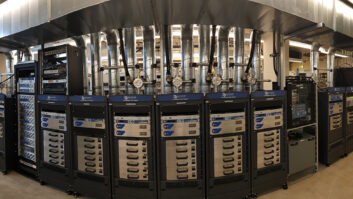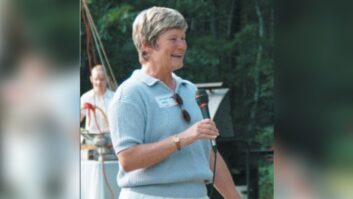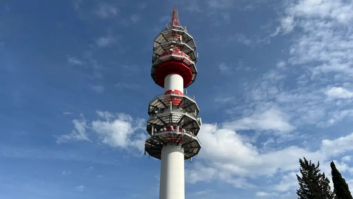We’ll start things off with some sage advice from Cliff Woodman.
Cliff works with the consulting firm Graham-Brock, which does quite a few Due Diligence inspections. In the largest majority of cases, they find inadequate Public Inspection Files.
The most common reply from station clients is, “I didn’t know what was supposed to be in there.”
The commission’s rules can be intimidating and confusing. So with that in mind, Cliff put together a “user friendly” 5-Step Program to a Better Public Inspection File. It’s complete with pictures, too!
Here is the link: www.grahambrock.com/public_file.htm So far, Cliff reports the response has been positive. These guys have done it right; they even provide file folder labels you can download and print on Avery Labels, so the file folders look organized.
(click thumbnail)Fig. 1: Step-by-step instructions to create a legal public file can be found at the Graham-Brock Web site.
Remember, the Public Inspection File is one of the big inspection items, so don’t blow this off. If you’re not in charge of the public file for your stations, be a team player and route this link to the appropriate party – and copy the GM. She needs to know you’re watching out for her station, and not just spending her money.
Are you a contract engineer? Here’s note of another way to generate revenue while saving clients a hefty fine. Offer a fixed fee service to check the file, then charge by the hour to correct omissions.
I’m glad to see that Graham-Brock is offering Due Diligence inspections, and that potential owners are conducting these inspections before they buy. It’s cheap insurance.
Although most qualified engineers can perform these inspections, few hold the liability insurance to make it worth their while. Making a quick buck can blow up in your face if you miss something and cost the potential buyer big money. Unless you hold the insurance certificate, in today’s litigious society, leave this job for the guys who are insured.
Reach Cliff at [email protected].

. . .
Radio World columnist Alan Peterson started a new position in March as assistant chief engineer at Radio America Networks in Washington. His first task was to work on two uncooperative 360 Systems Instant Replays.
The problem? They wouldn’t always start when the Play buttons were pressed. All other functions seemed fine, so the rubber button membranes were assumed to be the faulty components.
(click thumbnail)Fig. 2: The goop that fouled the Instant Replays.
Once the first player was disassembled, Alan noted a sticky film around the bottom edge of the Play button and a layer of goop on the PC board atop the Play button’s contact pads. The rubber showed no signs of disintegration, so this wasn’t the cause of the film. A coffee or soda spill would have affected more buttons, and the situation was identical on the second player.
The service techs at 360 Systems suggested cleaning the pads only with distilled water, but it turned out the stick-um wasn’t water-soluble. In fact, it looked and felt like rancid fat.
The most likely culprit: French-Fry Finger.
Over time, board ops who ate before or while on air probably transferred small amounts of fast-food grease via their fingertips to the Play button. The warmth of the unit let the oil flow down until it settled on the PC board. A small amount also was found on the Scroll Up/Down buttons.
While this is not recommended by the 360 Systems tech department, a cotton swab with a drop of Formula 409 household cleaner was gently used to dissolve the hardened grease, then followed up with a distilled water wipe. A new rubber pad for each player was added (about $30 each from the factory), and both went back into service.
When servicing an Instant Replay unit for intermittent buttons, take a minute and check the PC board as well. The button membrane may be at fault, but it is likely it won’t be the only problem.
Also, Alan hears that 360 Systems offers a retrofit kit that lets you use quieter IDE drives instead of the noisy and whiny SCSI drives in earlier units. It also cuts back on the amount of heat generated by the player. If you are upgrading an existing Instant Replay, ask the company about the conversion option.

. . .
George Marshall is a senior engineer at Clear Channel’s WHTZ, Z-100 in New York. George was reading a past Workbench column on nitrogen and possible asphyxiation, and was reminded of an incident that he experienced in the 1980s working in the Quad Cities.
(click thumbnail)Fig. 3: Burn the hose off the tank, it becomes a fire extinguisher.
His Class A FM dropped off the air one Saturday morning during a thunderstorm. Upon arriving at the site and opening the door, George could see charring and burn marks – from about four feet up from the floor all the way to the ceiling. What had happened here?
The best he could figure is that lightning had entered the building through the power lines and blew a lightning arrestor right off the wall. This set the building insulation on fire. When the flames got hot enough, they apparently burned the nitrogen hose right off the tank.
There was no fire suppression system in the shack; and from the scorch marks this fire was going good. He figures that the tank had enough volume and pressure to flood the transmitter room and put the fire out.
The “accident” saved the building, but getting back to full power still took three days. Seems lightning had also danced through the transmitter and exciter; so besides cleaning out all the soot. George was replacing components and removing carbon arc trails.
Oh, and as in my anecdote, when another line of storms came blowing through later in the day, George and his electrician decided it would be a good time for a coffee break instead of trying to get the power back on. Wise choice. No radio station is worthy dying for.
Reach George at [email protected].
Submissions for this column are encouraged, and qualify for SBE recertification credit.












